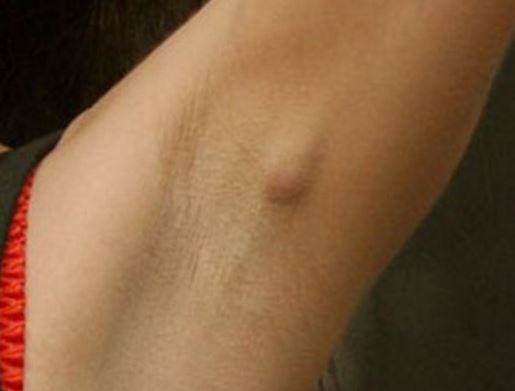When a woman finds a lump in her breast, it is definitely alarming, no matter the reasons for it. Many women will immediately think the lump might indicate breast cancer. But for women who are breastfeeding, it is important to remember that lumps in the breast are not serious, and are often caused by common reasons – not cancer! When a woman is breastfeeding, lump in armpit might occur because the breast tissue extends that far. Lumps that come and go aren’t causes for any concern at this point in a woman’s life.

What Causes Lump in Armpit While Breastfeeding?
Breast engorgement is the main reason why a woman who is breastfeeding might feel a lump under her armpit. That’s because the glands in the breast that create milk are filled too full, and the milk will overflow into the surrounding area, including the tissues under the armpit. Though it usually happens within the first five days after giving birth, it can happen anytime when a woman has not been able to fully empty her breasts. A severe breast engorgement should not be allowed to last more than 48 hours.
Breast engorgement can affect the entire breast and area around it. Besides lumps under the armpit, other symptoms include:
- Breasts that are throbbing and very warm to the touch
- Hard breasts
- Nipples that are flat, making it hard for a baby to latch
- A slight fever
How to Manage Lump in Armpit While Breastfeeding
Mothers will be happy to know that while breastfeeding, lump in armpit can easily go away with a few home remedies.
- If some milk is coming out of the breasts, use warm compresses for up to three minutes to help stimulate the milk flow. You can also stand under warm running water in the shower for a few minutes. If there is no milk coming out of the breasts at all, don’t use warm compresses, as this might increase the swelling.
- Nurse frequently. If your breasts are too full, you can try hand expressing a little milk for relief. This may be painful. Once some milk is out, it will be much better.
- When your baby begins to nurse, gently massage the breast that he/she is feeding from. This can allow the breast to drain a bit better.
- Use a breast pump if necessary to alleviate some of the pressure. Be sure to use the pump on the lowest setting and only for a few minutes.
- Always wear a very supportive bra designed specifically for nursing women.
- Apply cold packs to your breasts after nursing to relieve some of the pain. You might also be able to use over-the-counter pain medications; always check with the doctor first, since some medications are passed through breast milk.
Other Causes and Treatment Methods of Breast Lumps
When breastfeeding, lump in armpit is actually less common than breast lumps. Here are the causes and methods to deal with them.
1. Blocked Milk Duct
A blocked duct means that the milk has become trapped in the duct, forming a hard and painful lump. Treatments of a blocked duct include breastfeeding more often and changing positions to keep the breasts draining equally. Heat compress and massage can also provide relief. Without relief, a blocked duct can turn into breast engorgement or mastitis.
2. Breast Mastitis
This is an infection in the breasts. It is caused by breast engorgement, blocked milk ducts, and damaged tissue around the nipple. Common symptoms are hot, red, inflamed breasts, headache, nausea, fever, etc. Mastitis is a very serious infection that must have immediate attention. The coping methods include:
- Breastfeed frequently. Start by feeding from the breast that is not affected; then switch to the affected breast when let-down (milk ejection reflex) occurs. Mastitis will not affect the milk you give your baby.
- Use warm compresses. Warm water on the affected breast can help stimulate the let-down reflex, as well as ease the pain of the mastitis.
- Use ice. Apply cold compresses to the breast as soon as the breastfeeding session is over.
- Stay well hydrated and get plenty of rest.
- Use antibiotics. These are usually required to clear up the infection. Consult the doctor to make sure the safety of the medicines.
- Drain abscesses. The infection can intensify into pus-filled abscesses in the breast. These can be drained by a physician by using a long, thin needle; however, some serious abscesses must be opened up during a routine outpatient procedure.